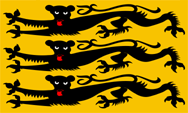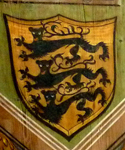mobile View, to the German Version tap the flag
![]()




 historical mural
historical mural746 · the old tribal duchy of the Alemanni is abolished
917–926 · Burchard the Younger is the first Duke of the newly founded tribal Duchy of the Swabians
926–1079 · Swabian is owned by the Franconian Conradines, the house of Babenberg and Rudolf von Rheinfelden
1079 · King Heinrich IV. hands over the duchy to Friedrich I. of Staufen (1050–1105)
1250 · Friedrich II. of Staufen, Duke of Swabia and German Emperor dies, no new Duke is appointed
1268 · the house of Hohenstaufen extincts, to get the legacy break out fights in Swabia, even under participation of the Counts of Württemberg, large areas of the country are conquered and divided, King Rudolf I. of Habsburg awards the title of the Duke of Swabia to his son Rudolf, after his death to his brother Johann, in this way the last Duke of Swabia, the disintegration of the country could not be prevented
Source: Wikipedia (D),
Discovery '97
The name "Swabia" goes back to the tribe of the Sueves, who settled in the region until the 5th century.
Source: Discovery '97